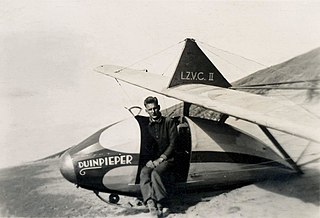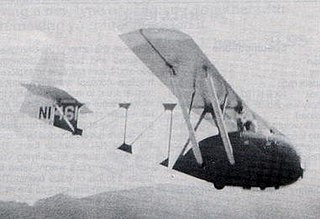
The London Gliding Club (LGC) is a members' club whose airfield is located at the foot of the Dunstable Downs. Many privately owned gliders are based there. It has the facilities to train pilots in powerless flight, and in the skills necessary to fly cross country using nature's sources of energy. Aerobatics and instructor training are also available. The LGC is open 364 days a year and is the second largest and one of the oldest Gliding Clubs in the United Kingdom, smaller only than Lasham Gliding Society. The club provides gliding courses, one day courses and trial lessons for members of the public.

The Slingsby T.38 Grasshopper is a British primary training glider built by Slingsby Sailplanes for the Royal Air Force.

Dart Aircraft Limited was a British aircraft manufacturer during the 1930s. Its facilities were located at 29 High Street North, Dunstable, Bedfordshire.

A glider is a fixed-wing aircraft that is supported in flight by the dynamic reaction of the air against its lifting surfaces, and whose free flight does not depend on an engine. Most gliders do not have an engine, although motor-gliders have small engines for extending their flight when necessary by sustaining the altitude with some being powerful enough to take off by self-launch.

The Elliots Primary EoN or EoN Type 7 S.G.38 Primary was a training glider built in the UK shortly after World War II. It was an absolutely minimalist aircraft, consisting of a high, cable-braced wing connected to a conventional empennage by an open-truss framework, and was a copy of the German SG 38 Schulgleiter. Marketed to aeroclubs, the Primary EoN was also adopted in 1948 by the Air Training Corps and by the Combined Cadet Force under the name Eton TX.1. An example is at the Gliding Heritage Centre.

The Schweizer SGU 1-7 is an American Open Class, single-seat, high-wing strut braced glider built by Schweizer Metal Aircraft Company of Elmira, New York.
The Schweizer SGP 1-1 is an American, amateur-built, single-seat, high-wing primary glider that was designed by Ernest Schweizer and constructed by the Mercury Glider Club between 1929 and 1930.
The Schweizer SGU 1-19 and Schweizer SGU 1-20 are a family of United States single-seat, high-wing, strut-braced, utility gliders built by Schweizer Aircraft of Elmira, New York.

The Slingsby T.21 is an open-cockpit, side-by-side two-seat glider, built by Slingsby Sailplanes Ltd and first flown in 1944. It was widely used by the Royal Air Force, Sri Lanka Air Force and by civilian gliding clubs.

Gliding is a recreational activity and competitive air sport in which pilots fly unpowered aircraft known as gliders or sailplanes using naturally occurring currents of rising air in the atmosphere to remain airborne. The word soaring is also used for the sport.

A glider or sailplane is a type of glider aircraft used in the leisure activity and sport of gliding. This unpowered aircraft can use naturally occurring currents of rising air in the atmosphere to gain altitude. Sailplanes are aerodynamically streamlined and so can fly a significant distance forward for a small decrease in altitude.

The Zögling is a German high-wing, cable-braced, single seat primary glider that was designed by Alexander Lippisch in 1926 and produced with many variations by a variety of manufacturers.

The Schneider DFS 108-14 SG-38 Schulgleiter is a German high-wing, cable-braced, single-seat primary glider that was designed by Schneider, Rehberg and Hofmann at Edmund Schneider's factory at Grunau in 1938, hence the designation. It was produced by several builders, including Deutsche Forschungsanstalt für Segelflug (DFS).

The Jongblood Primary is an American single-seat, high-wing, strut-braced primary glider designed by Mike Jongblood of southern California and first flown in 1967. The aircraft is unusual in that primary gliders went out of fashion in the 1930s and few have been built since.

The US Southwest Soaring Museum is an aviation museum, located at 918 E US Route 66, in Moriarty, New Mexico, United States that focuses on the history of gliding in the western United States. The museum is an affiliate member of the Soaring Society of America.

The Maupin Carbon Dragon is an American, high-wing, single-seat, glider that was designed by Jim Maupin and made available as plans for amateur construction. Plans are no longer available.
The Bonomi BS.11 Milano and BS.12 Roma were primary gliders designed and built in Italy in the 1930s. Only about six were produced.
The Bonomi BS.16 Allievo Bonomi was a single seat primary glider, designed and built in Italy in 1930 and widely used by flying clubs.

The RRG Falke of 1930 was a secondary training glider designed by Alexander Lippisch in Germany and intended to provide better performance than his earlier RRG Prüfling whilst being easier to fly because of its inherent stability. It was sold as plans for both club and commercial production and was built in Germany and abroad.















